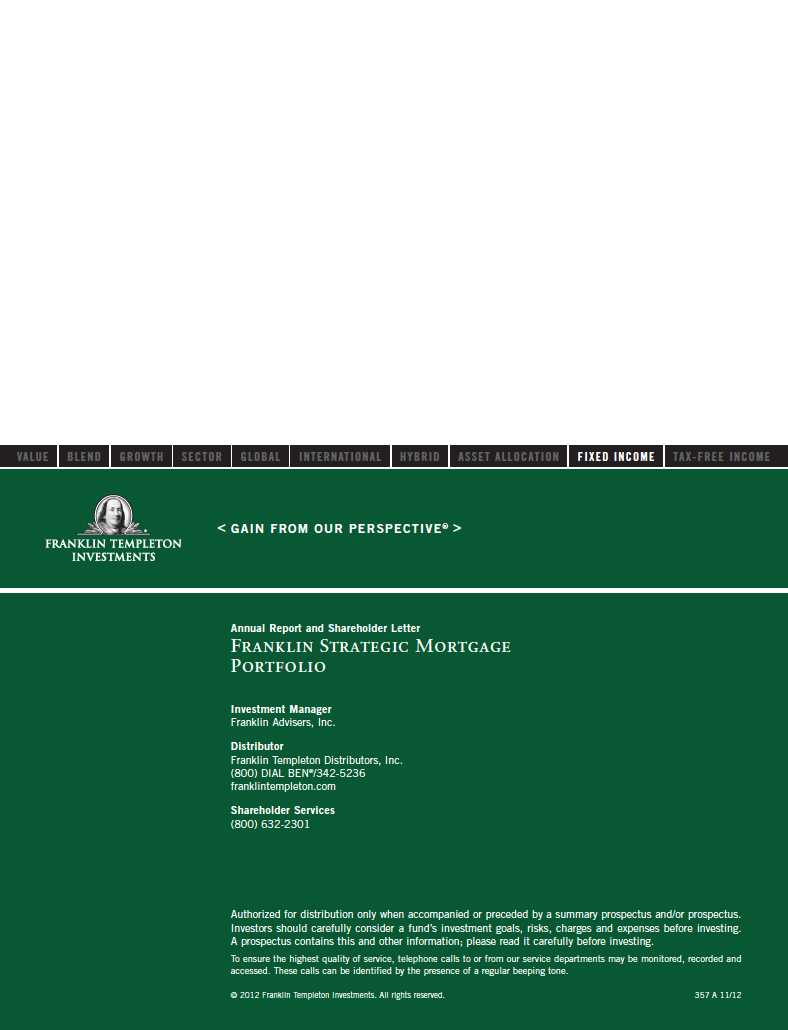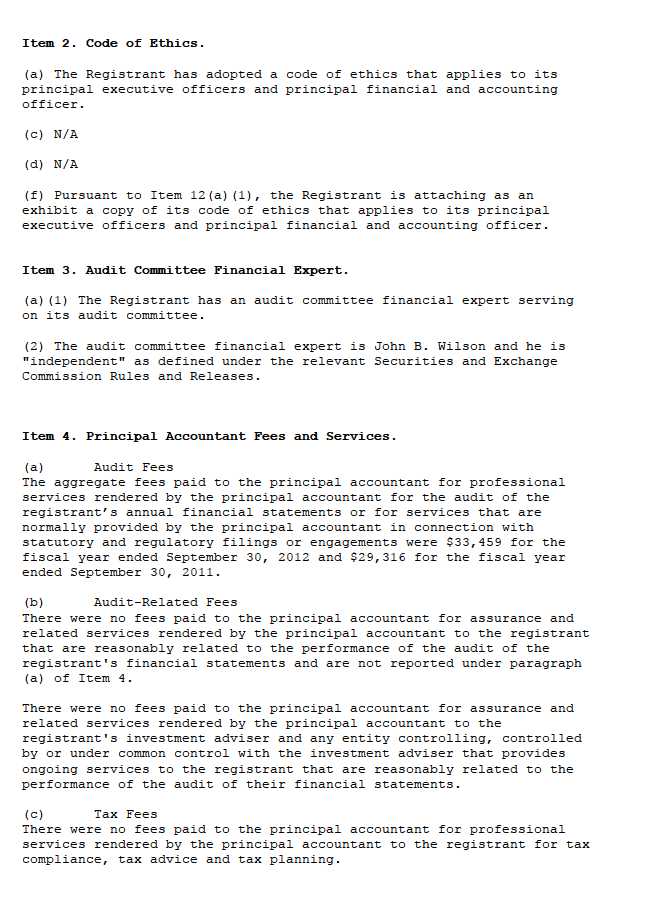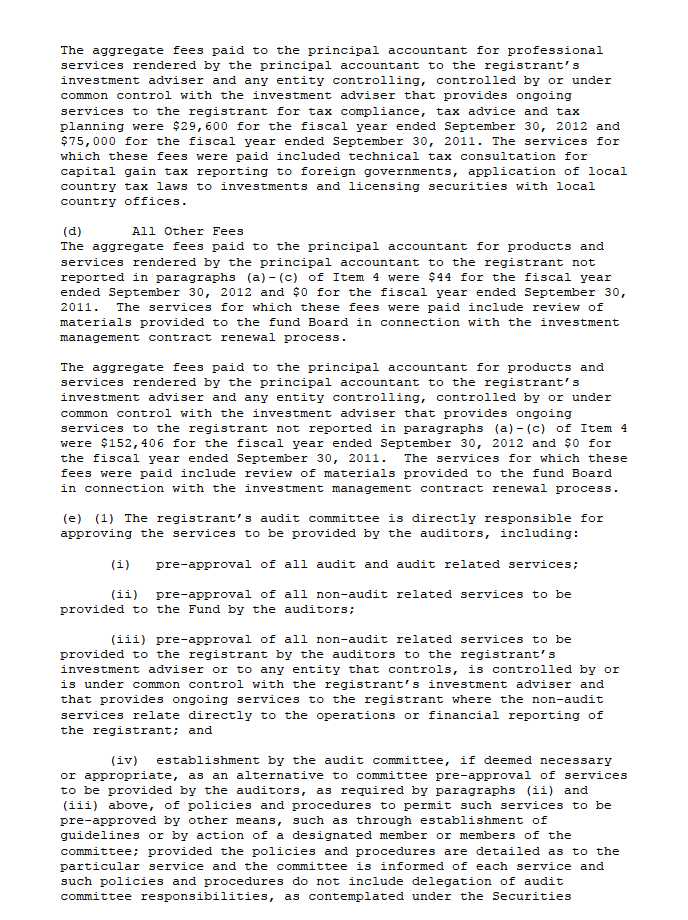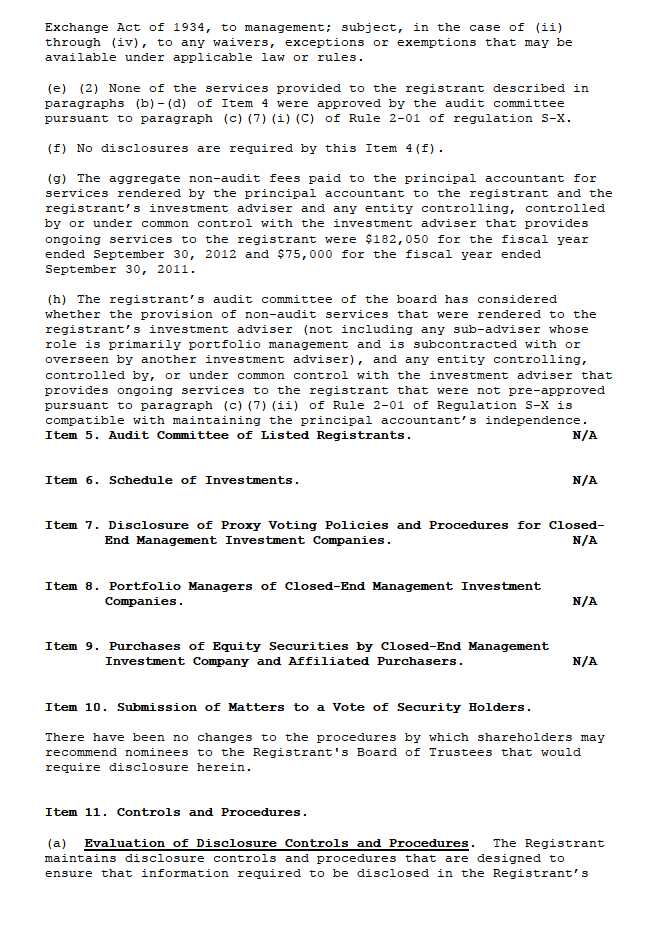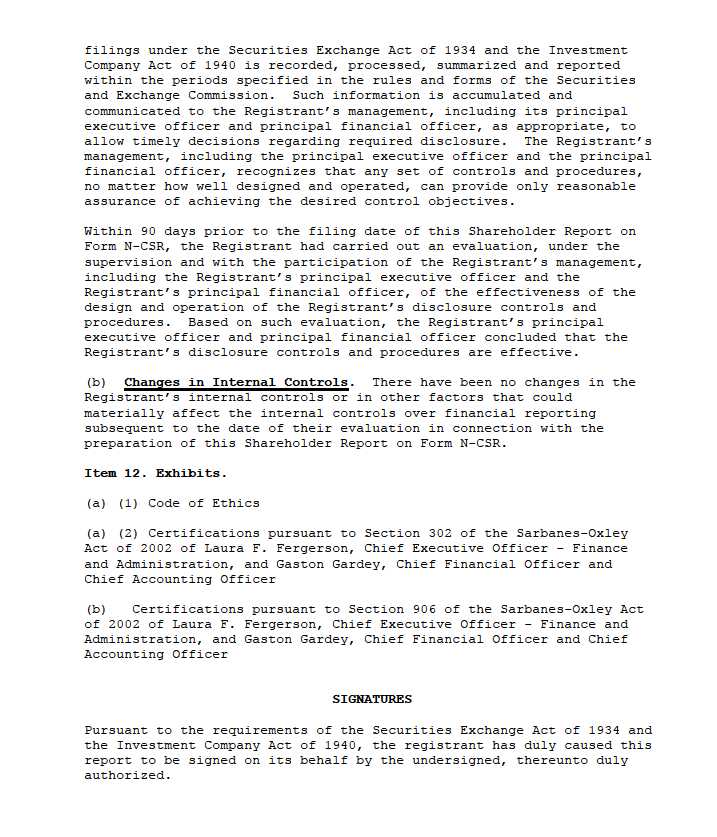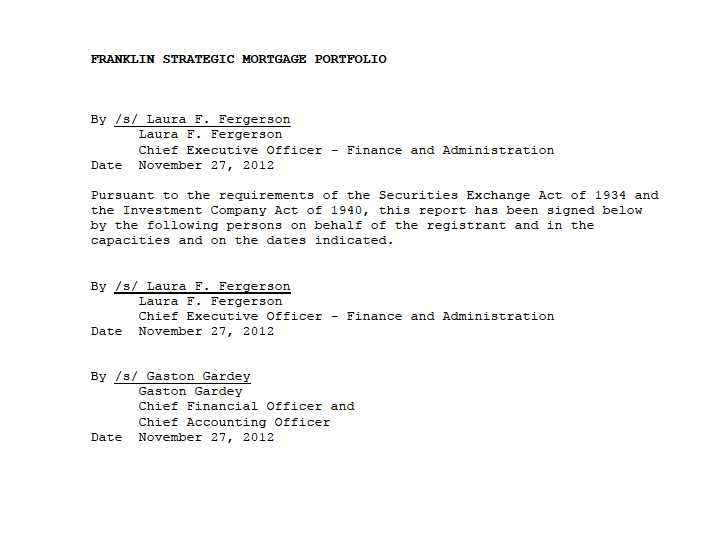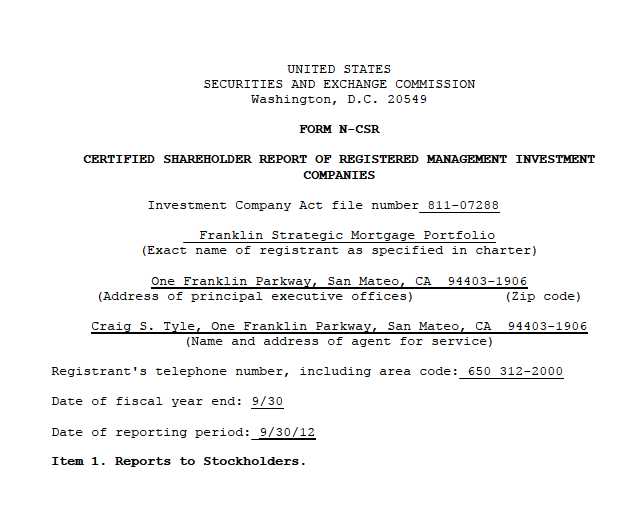
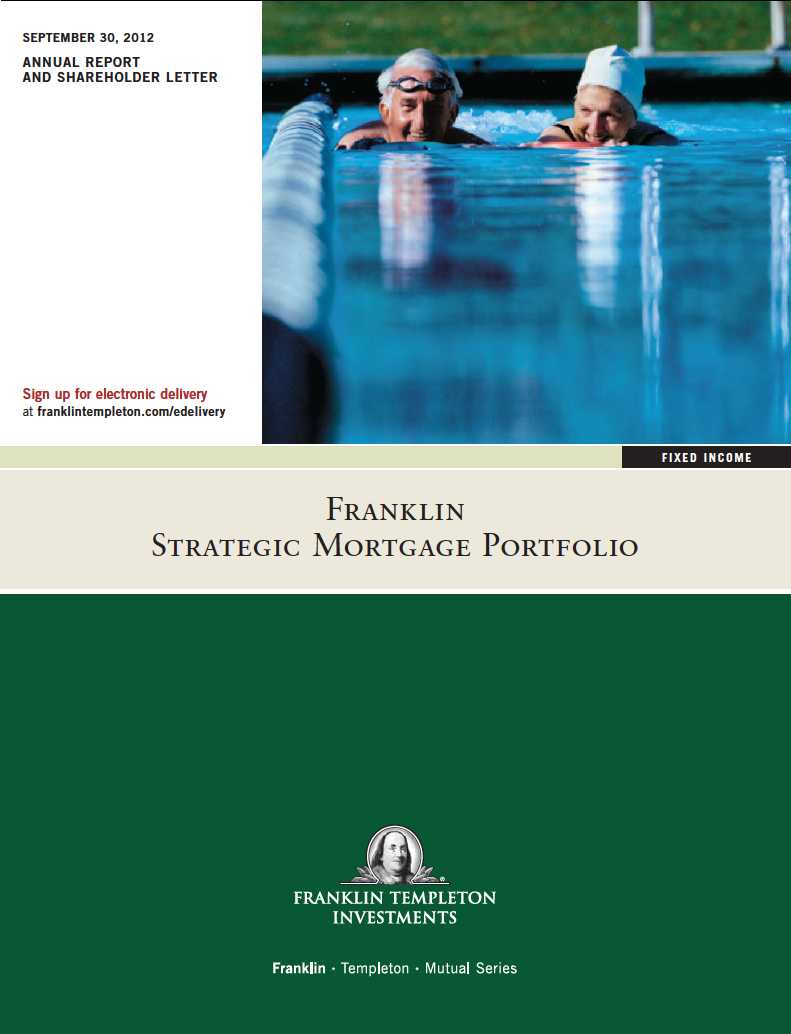

Annual Report
Franklin Strategic Mortgage Portfolio
Your Fund s Goal and Main Investments: Franklin Strategic Mortgage Portfolio seeks high total return (a combination of high current income and capital appreciation) relative to the performance of the general mortgage securities market by investing at least 80% of its net assets in a portfolio of mortgage securities. The Fund normally focuses its investments in mortgage pass-through securities, which are securities representing interests in pools of mortgage loans issued or guaranteed by the U.S. government, its agencies or instrumentalities. Some of the Fund s investments may include securities issued by government-sponsored entities, such as Fannie Mae and Freddie Mac.1
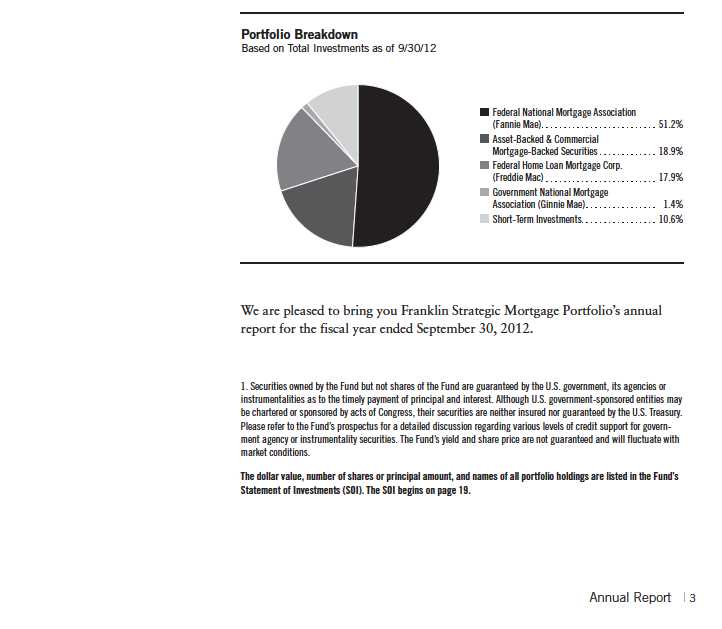
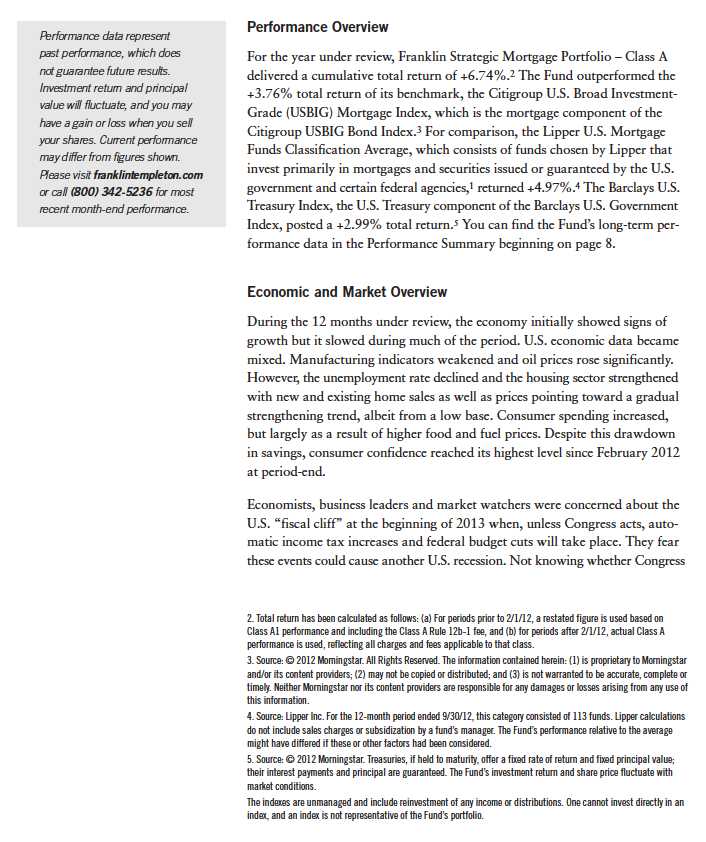
4 | Annual Report
and the President will avert these measures after the U.S. election, many businesses delayed major investment and hiring decisions. Seeking to support a stronger economic recovery, the Federal Reserve Board acknowledged the need for further policy accommodation and announced in September a third round of quantitative easing (QE3). QE3 consisted of $40 billion monthly purchases of mortgage-backed securities until the labor market improves. The Fed also continued buying long-term Treasuries and selling short-term Treasuries in an effort to put downward pressure on long-term interest rates.
The announcement of QE3 as well as ongoing investor concerns about euro-zone uncertainty, drove the 10-year U.S. Treasury note yield from 1.92% on September 30, 2011, to 1.65% on September 30, 2012. During the 12 months under review, investment-grade fixed income markets, as measured by the Barclays U.S. Aggregate Index, produced solid returns but underperformed high yield corporate bonds, as measured by the Credit Suisse High Yield Index. U.S. stocks, as measured by the Standard & Poor s® 500 Index, fluctuated as investors apparently reacted to news headlines and shifted between risk taking and risk aversion.6 Ultimately, stocks generated a robust 12-month gain.
Investment Strategy
We invest at least 80% of the Fund s net assets in mortgage securities. The Fund invests substantially in mortgage securities that are issued or guaranteed by the U.S. government, its agencies or instrumentalities, which include mortgage pass-through securities representing interests in pools of mortgage loans issued or guaranteed by the Government National Mortgage Association (Ginnie Mae), Fannie Mae and Freddie Mac.1 We may also invest in other types of mortgage securities that may be issued by private issuers, in U.S. Treasuries and in mortgage loans. At least 80% of total assets are invested in securities rated BBB or higher by Standard & Poor s (S&P), or Baa by Moody s Investors Service (Moody s), independent credit rating agencies. Within these parameters, we rely on our research to help us identify attractive investment opportunities.
Manager s Discussion
All fixed income sectors in which the Fund invests posted positive returns and outperformed U.S. Treasuries. As measured by Barclays indexes, commercial mortgage-backed securities (CMBS) posted the best absolute performance during the period, followed by U.S. residential mortgage-backed securities (MBS), asset-backed securities and U.S. Treasuries.
6. STANDARD & POOR S®, S&P® and S&P 500® are registered trademarks of Standard & Poor s Financial Services LLC.
Annual Report | 5
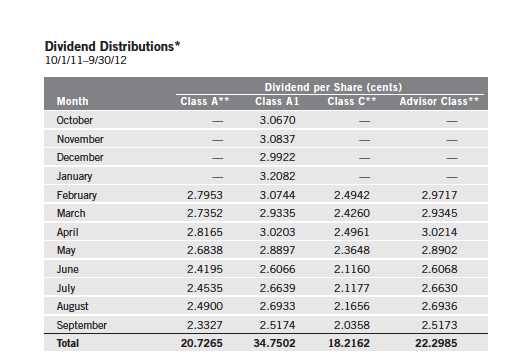
*Assumes shares were purchased and held for the entire accrual period. Since dividends accrue daily, your actual dis-
tributions will vary depending on the date you purchased your shares and any account activity. All Fund distributions
will vary depending upon current market conditions, and past distributions are not indicative of future trends.
**Effective 2/1/12, Class A shares closed to new investors and were renamed Class A1. A new Class A share, with a
25 basis point (0.25%) Rule 12b-1 fee, was available to investors as of 2/1/12; Class C and Advisor Class shares
were also added.
Valuations in the MBS sector were, in our opinion, more fairly valued and
received additional support from market conditions including a negative net
supply of mortgages, additional Fed purchases, reinvestment of pay downs
and bank and mortgage REIT demand. With mortgage rates at historical lows,
we believe prepayment levels may continue to rise as they did in August and
September 2012, although not to the extent reached in past prepayment waves.
Factors including a decline in home price appreciation, loss of home equity,
tighter underwriting standards and originator processing capacity continued
to mitigate prepayment activity.
The Fund s broad mortgage strategy looks across all mortgage opportunity
sets to find relative value. The investment team continued to look for strong
cash flow fundamentals and valuations to uncover opportunities across the
mortgage investment universe. The Fund had the heaviest allocation to lower
coupon 3.5% securities as we increased our allocation in those coupons and
reduced our exposure to 4.5% through 6.0% MBS.
6 | Annual Report
We added select securities from the CMBS sector as well as fundamentally sound bonds at what we considered attractive valuations in non-agency mortgage securities. The Fund maintained strong exposure to CMBS, but shifted its allocation lower in the capital structure. Although credit fundamentals showed signs of stabilization, we believe the commercial real estate landscape could remain challenged over the intermediate term.
The Fund s sector allocation benefited performance. Non-agency residential MBS and CMBS exposure provided the most significant boosts to performance and agency MBS also contributed to returns. Our shorter duration positioning detracted from performance over the period, however, as interest rates moved lower.
Thank you for your continued participation in Franklin Strategic Mortgage Portfolio. We look forward to serving your future investment needs.

The foregoing information reflects our analysis, opinions and portfolio holdings as of September 30, 2012, the end of the reporting period. The way we implement our main investment strategies and the resulting portfolio holdings may change depending on factors such as market and economic conditions. These opinions may not be relied upon as investment advice or an offer for a particular security. The information is not a complete analysis of every aspect of any market, country, industry, security or the Fund. Statements of fact are from sources considered reliable, but the investment manager makes no representation or warranty as to their completeness or accuracy. Although historical performance is no guarantee of future results, these insights may help you understand our investment management philosophy.
Annual Report | 7
Performance Summary as of 9/30/12
Your dividend income will vary depending on dividends or interest paid by securities in the Fund s portfolio, adjusted for operating expenses. Capital gain distributions are net profits realized from the sale of portfolio securities. The performance table and graphs do not reflect any taxes that a shareholder would pay on Fund dividends, capital gain distributions, if any, or any realized gains on the sale of Fund shares. Total return reflects reinvestment of the Fund s dividends and capital gain distributions, if any, and any unrealized gains or losses.
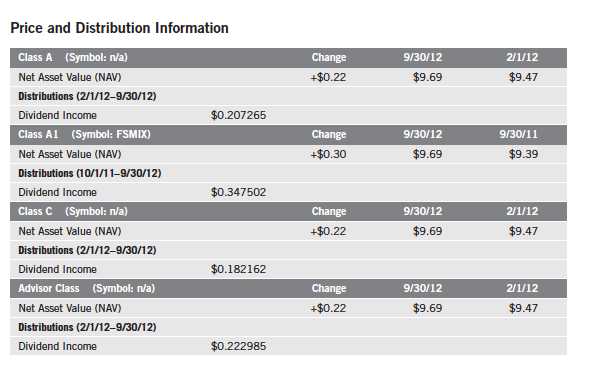
8 | Annual Report
Performance Summary (continued)
Performance
Cumulative total return excludes the sales charge. Aggregate and average annual total returns include maximum sales charges. Class A/A1: 4.25% maximum initial sales charge. Class C: 1% contingent deferred sales charge in first year only; Advisor Class: no sales charges.
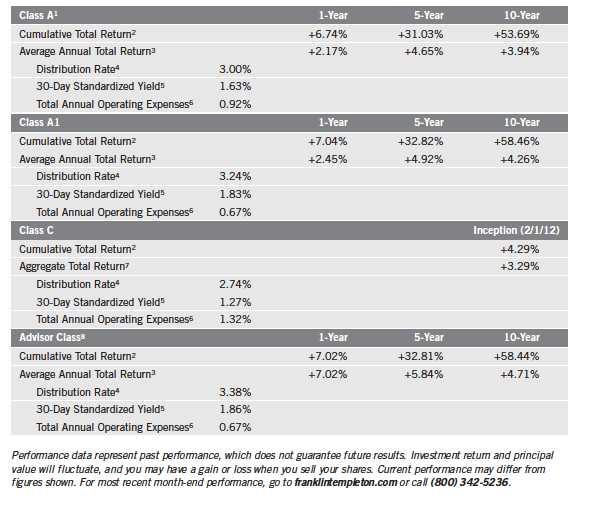
Annual Report | 9
Performance Summary (continued)
Total Return Index Comparison for a Hypothetical $10,000 Investment
Total return represents the change in value of an investment over the periods shown. It includes the applicable maximum sales charge, Fund expenses, account fees and reinvested distributions. The unmanaged index includes reinvestment of any income or distributions. It differs from the Fund in composition and does not pay management fees or expenses. One cannot invest directly in an index.
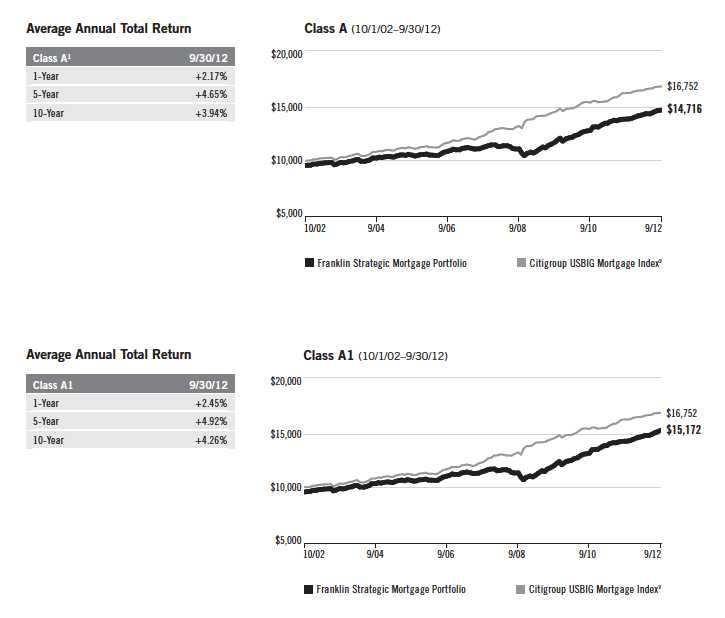
10 | Annual Report
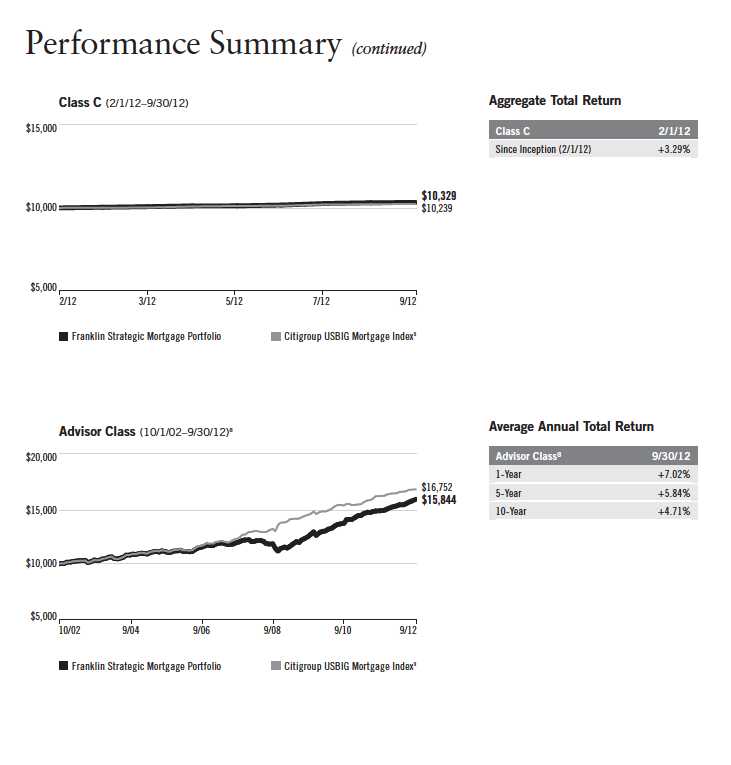
Annual Report | 11
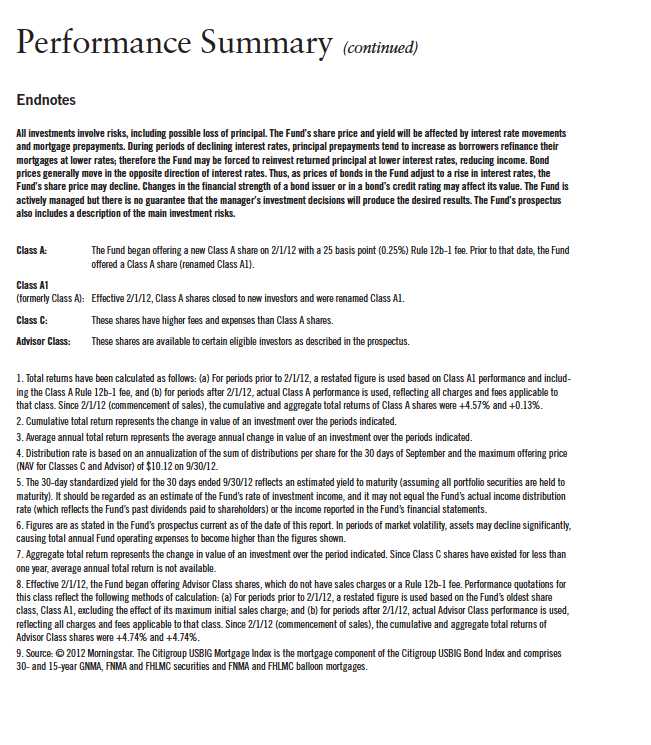
12 | Annual Report
Your Fund s Expenses
As a Fund shareholder, you can incur two types of costs:
- Transaction costs, including sales charges (loads) on Fund purchases; and
- Ongoing Fund costs, including management fees, distribution and service (12b-1) fees, and other Fund expenses. All mutual funds have ongoing costs, sometimes referred to as operating expenses.
The following table shows ongoing costs of investing in the Fund and can help you understand these costs and compare them with those of other mutual funds. The table assumes a $1,000 investment held for the six months indicated.
Actual Fund Expenses
The first line (Actual) for each share class listed in the table provides actual account values and expenses. The Ending Account Value is derived from the Fund s actual return, which includes the effect of Fund expenses.
You can estimate the expenses you paid during the period by following these steps. Of course, your account value and expenses will differ from those in this illustration:
| 1. | Divide your account value by $1,000. |
| If an account had an $8,600 value, then $8,600 ÷ $1,000 = 8.6. | |
| 2. | Multiply the result by the number under the heading Expenses Paid During Period. |
| If Expenses Paid During Period were $7.50, then 8.6 x $7.50 = $64.50. |
In this illustration, the estimated expenses paid this period are $64.50.
Hypothetical Example for Comparison with Other Funds
Information in the second line (Hypothetical) for each class in the table can help you compare ongoing costs of investing in the Fund with those of other mutual funds. This information may not be used to estimate the actual ending account balance or expenses you paid during the period. The hypothetical Ending Account Value is based on the actual expense ratio for each class and an assumed 5% annual rate of return before expenses, which does not represent the Fund s actual return. The figure under the heading Expenses Paid During Period shows the hypothetical expenses your account would have incurred under this scenario. You can compare this figure with the 5% hypothetical examples that appear in shareholder reports of other funds.
Annual Report | 13
Your Fund s Expenses (continued)
Please note that expenses shown in the table are meant to highlight ongoing costs and do not reflect any transaction costs, such as sales charges. Therefore, the second line for each class is useful in comparing ongoing costs only, and will not help you compare total costs of owning different funds. In addition, if transaction costs were included, your total costs would have been higher. Please refer to the Fund prospectus for additional information on operating expenses.
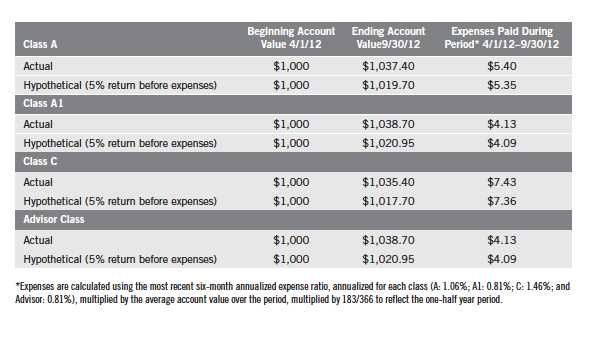
14 | Annual Report
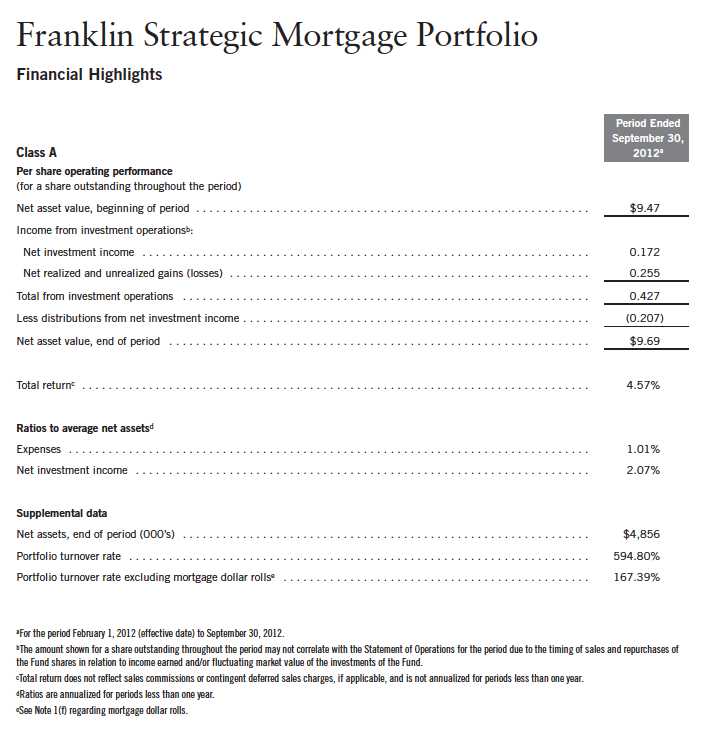
Annual Report | The accompanying notes are an integral part of these financial statements. | 15
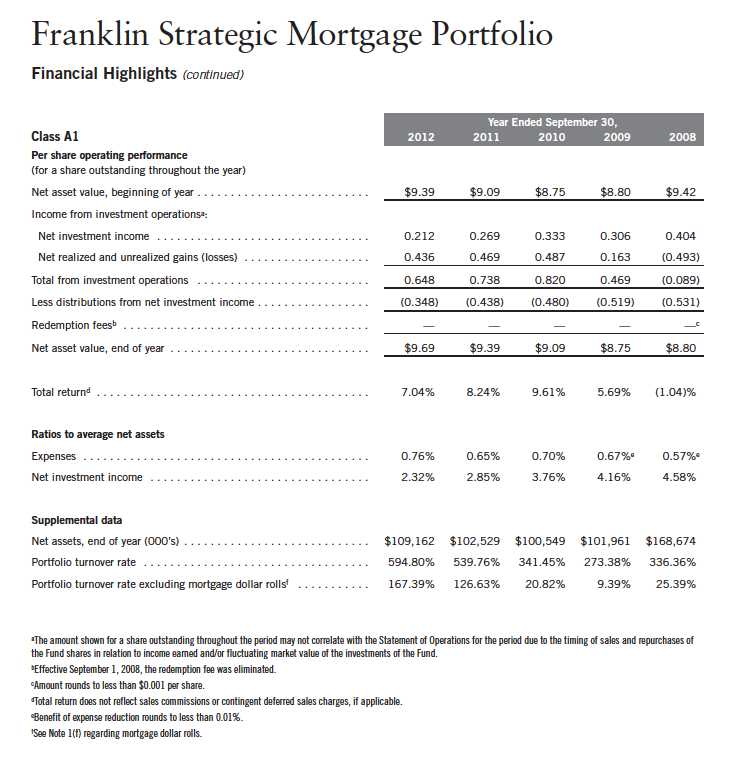
16 | The accompanying notes are an integral part of these financial statements. | Annual Report
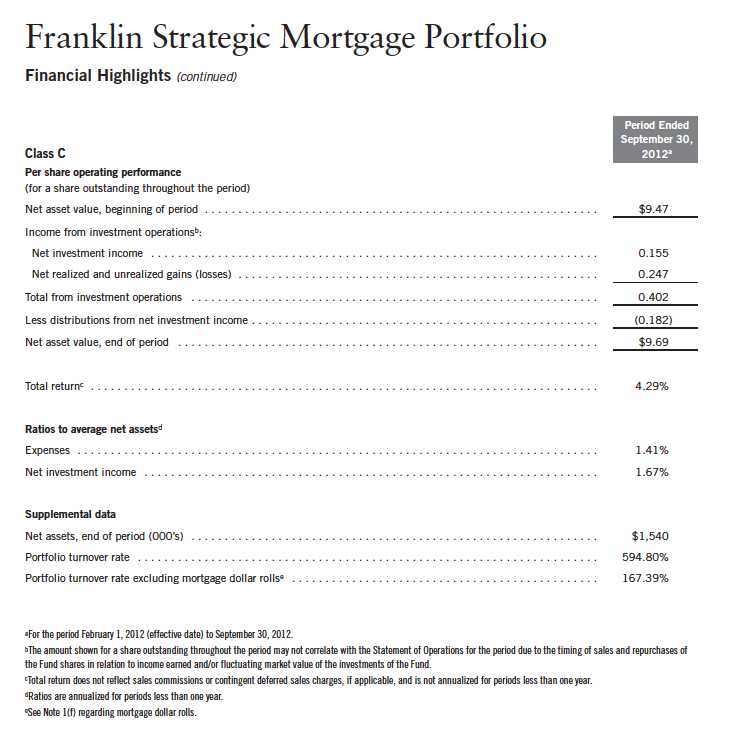
Annual Report | The accompanying notes are an integral part of these financial statements. | 17
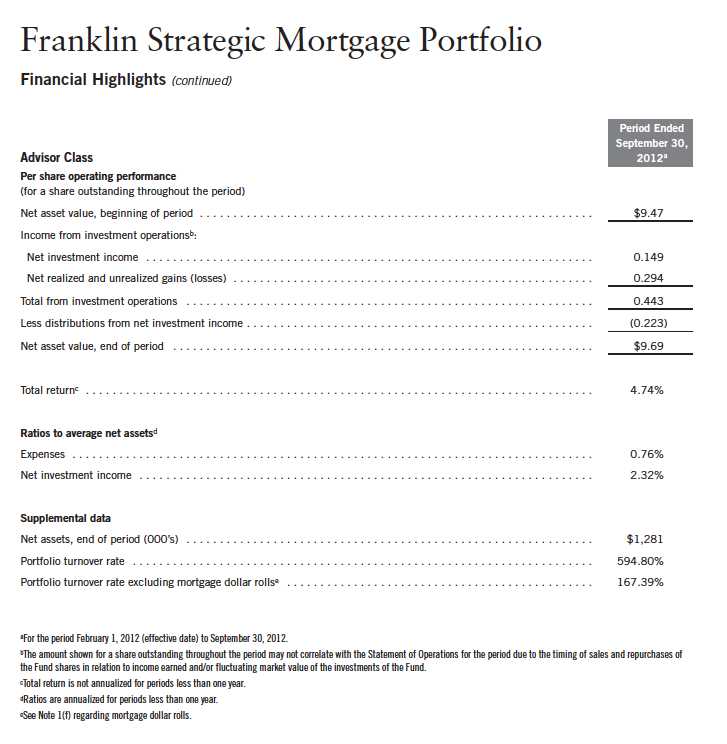
18 | The accompanying notes are an integral part of these financial statements. | Annual Report
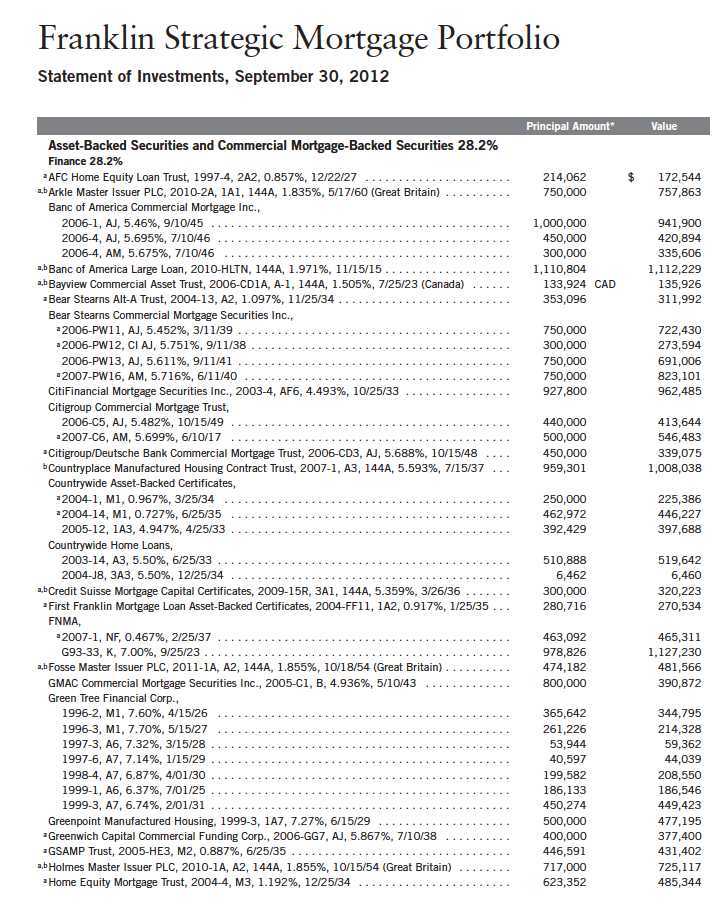
Annual Report | 19
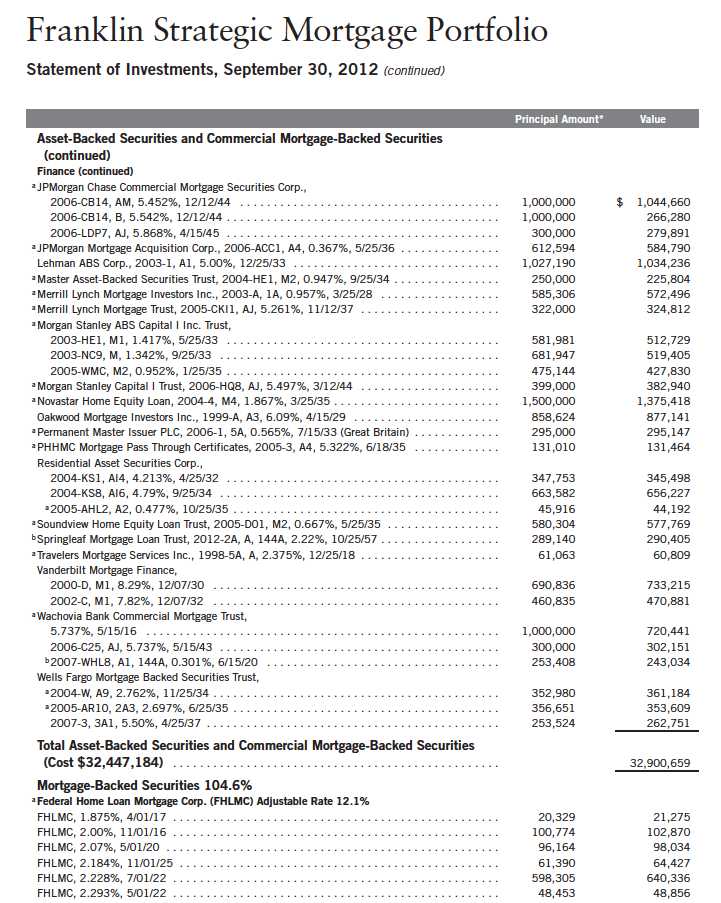
20 | Annual Report
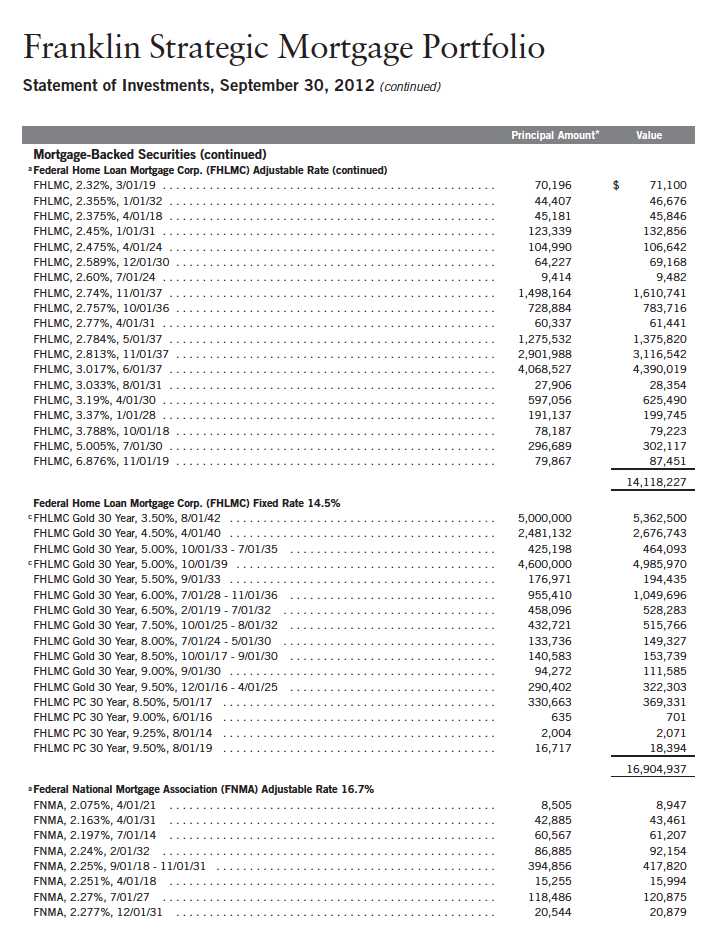
Annual Report | 21
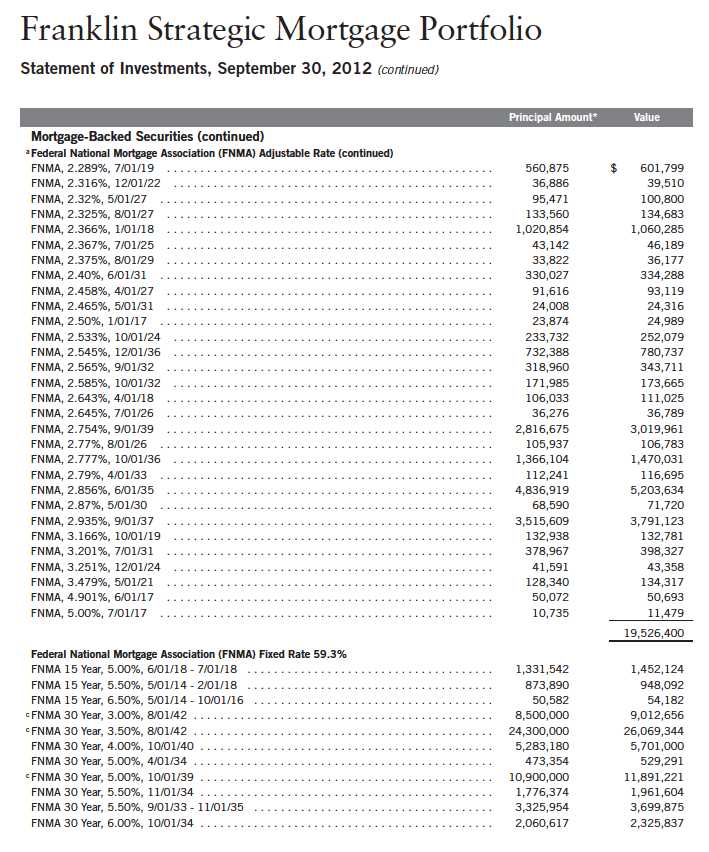
22 | Annual Report
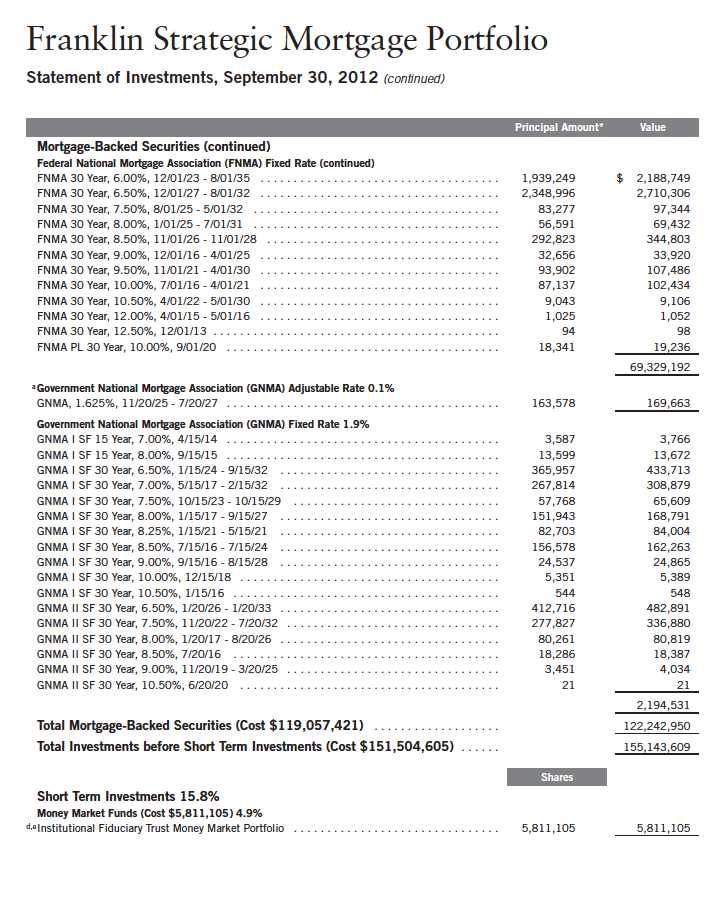
Annual Report | 23
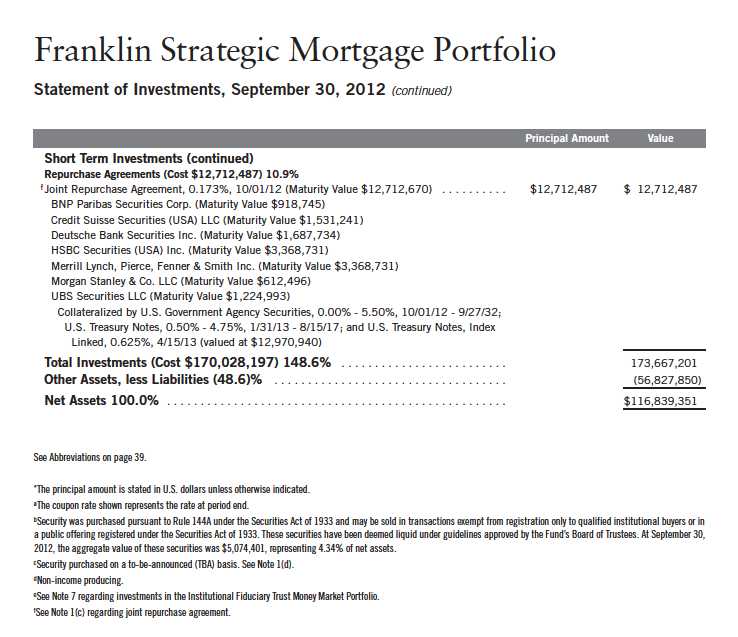
24 | The accompanying notes are an integral part of these financial statements. | Annual Report
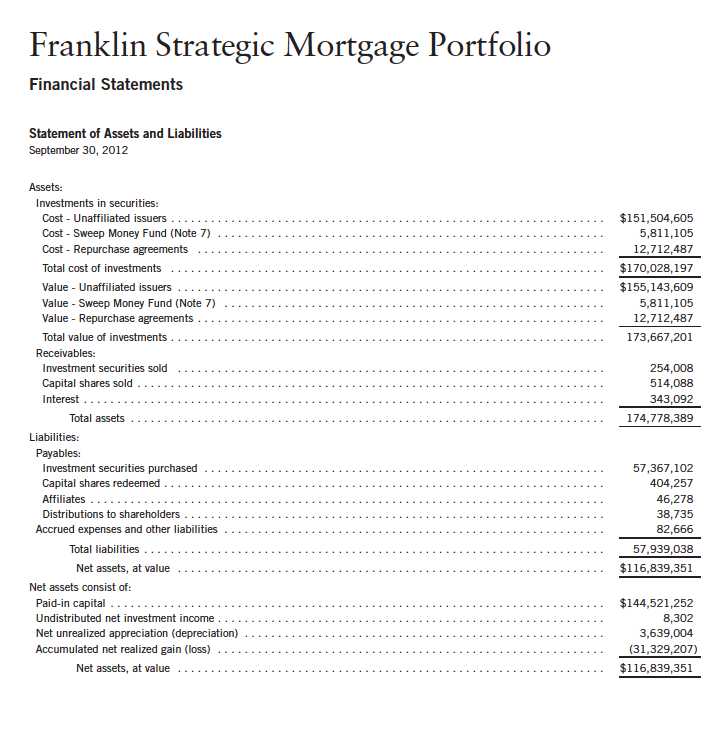
Annual Report | The accompanying notes are an integral part of these financial statements. | 25
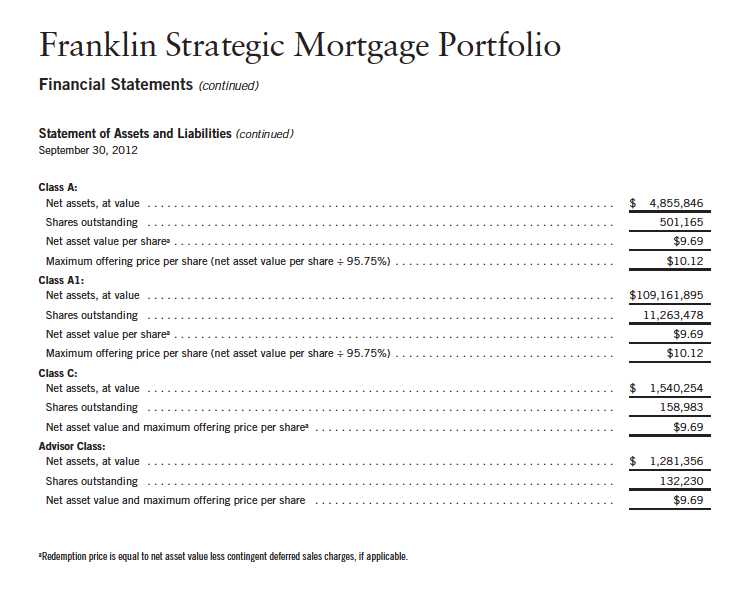
26 | The accompanying notes are an integral part of these financial statements. | Annual Report
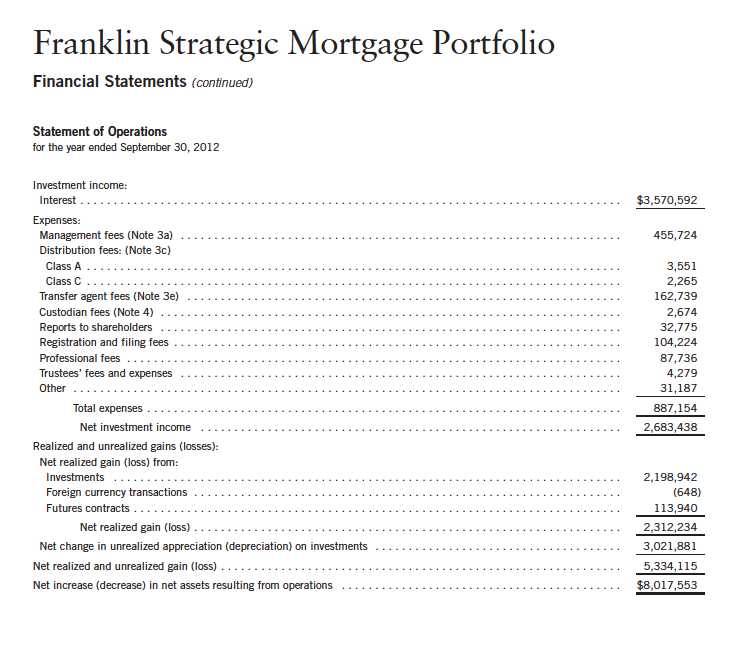
Annual Report | The accompanying notes are an integral part of these financial statements. | 27
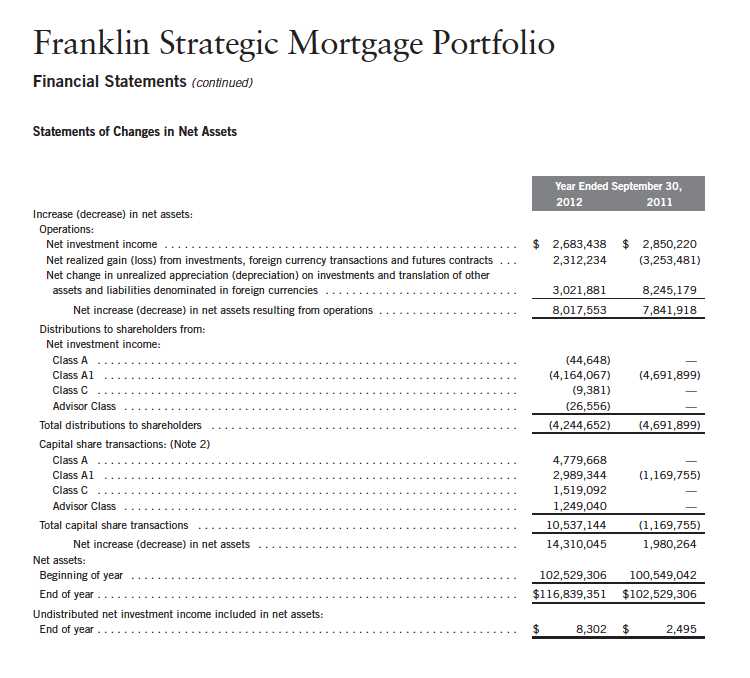
28 | The accompanying notes are an integral part of these financial statements. | Annual Report
Franklin Strategic Mortgage Portfolio
Notes to Financial Statements
1. ORGANIZATION AND SIGNIFICANT ACCOUNTING POLICIES
Franklin Strategic Mortgage Portfolio (Trust) is registered under the Investment Company Act of 1940, as amended, (1940 Act) as an open-end investment company, consisting of one fund, the Franklin Strategic Mortgage Portfolio (Fund). The Fund offers four classes of shares: Class A, Class A1, Class C, and Advisor Class. Each class of shares differs by its initial sales load, contingent deferred sales charges, distribution fees, voting rights on matters affecting a single class and its exchange privilege.
Effective February 1, 2012, Class A shares were renamed A1, and the Fund began offering three new classes of shares, Class A, Class C, and Advisor Class. Class A1 shares are only offered to existing Class A1 shareholders.
The following summarizes the Fund s significant accounting policies.
a. Financial Instrument Valuation
The Fund s investments in financial instruments are carried at fair value daily. Fair value is the price that would be received to sell an asset or paid to transfer a liability in an orderly transaction between market participants on the measurement date. Under procedures approved by the Fund s Board of Trustees (the Board), the Fund s administrator, investment manager and other affiliates have formed the Valuation and Liquidity Oversight Committee (VLOC). The VLOC provides administration and oversight of the Fund s valuation policies and procedures, which are approved annually by the Board. Among other things, these procedures allow the Fund to utilize independent pricing services, quotations from securities and financial instrument dealers, and other market sources to determine fair value.
Debt securities generally trade in the over-the-counter market rather than on a securities exchange. The Fund s pricing services use multiple valuation techniques to determine fair value. In instances where sufficient market activity exists, the pricing services may utilize a market-based approach through which quotes from market makers are used to determine fair value. In instances where sufficient market activity may not exist or is limited, the pricing services also utilize proprietary valuation models which may consider market characteristics such as benchmark yield curves, credit spreads, estimated default rates, anticipated market interest rate volatility, coupon rates, anticipated timing of principal repayments, underlying collateral, and other unique security features in order to estimate the relevant cash flows, which are then discounted to calculate the fair value. Securities denominated in a foreign currency are converted into their U.S. dollar equivalent at the foreign exchange rate in effect at the close of the NYSE on the date that the values of the foreign debt securities are determined. Investments in open-end mutual funds are valued at the closing net asset value. Repurchase agreements are valued at cost, which approximates market value.
Annual Report | 29
Franklin Strategic Mortgage Portfolio
Notes to Financial Statements (continued)
| 1. | ORGANIZATION AND SIGNIFICANT ACCOUNTING POLICIES (continued) |
| a. | Financial Instrument Valuation (continued) |
The Fund has procedures to determine the fair value of financial instruments for which market prices are not reliable or readily available. Under these procedures, the VLOC convenes on a regular basis to review such financial instruments and considers a number of factors, including significant unobservable valuation inputs, when arriving at fair value. The VLOC primarily employs a market-based approach which may use related or comparable assets or liabilities, recent transactions, market multiples, book values, and other relevant information for the investment to determine the fair value of the investment. An income-based valuation approach may also be used in which the anticipated future cash flows of the investment are discounted to calculate fair value. Discounts may also be applied due to the nature or duration of any restrictions on the disposition of the investments. Due to the inherent uncertainty of valuations of such investments, the fair values may differ significantly from the values that would have been used had an active market existed. The VLOC employs various methods for calibrating these valuation approaches including a regular review of key inputs and assumptions, transactional back-testing or disposition analysis, and reviews of any related market activity.
b. Foreign Currency Translation
Portfolio securities and other assets and liabilities denominated in foreign currencies are translated into U.S. dollars based on the exchange rate of such currencies against U.S. dollars on the date of valuation. The Fund may enter into foreign currency exchange contracts to facilitate transactions denominated in a foreign currency. Purchases and sales of securities, income and expense items denominated in foreign currencies are translated into U.S. dollars at the exchange rate in effect on the transaction date. Portfolio securities and assets and liabilities denominated in foreign currencies contain risks that those currencies will decline in value relative to the U.S. dollar. Occasionally, events may impact the availability or reliability of foreign exchange rates used to convert the U.S. dollar equivalent value. If such an event occurs, the foreign exchange rate will be valued at fair value using procedures established and approved by the Board.
The Fund does not separately report the effect of changes in foreign exchange rates from changes in market prices on securities held. Such changes are included in net realized and unrealized gain or loss from investments on the Statement of Operations.
Realized foreign exchange gains or losses arise from sales of foreign currencies, currency gains or losses realized between the trade and settlement dates on securities transactions and the difference between the recorded amounts of dividends, interest, and foreign withholding taxes and the U.S. dollar equivalent of the amounts actually received or paid. Net unrealized foreign exchange gains and losses arise from changes in foreign exchange rates on foreign denominated assets and liabilities other than investments in securities held at the end of the reporting period.
30 | Annual Report
Franklin Strategic Mortgage Portfolio
Notes to Financial Statements (continued)
| 1. | ORGANIZATION AND SIGNIFICANT ACCOUNTING POLICIES (continued) |
| c. | Joint Repurchase Agreement |
The Fund enters into a joint repurchase agreement whereby its uninvested cash balance is deposited into a joint cash account with other funds managed by the investment manager or an affiliate of the investment manager and is used to invest in one or more repurchase agreements. The value and face amount of the joint repurchase agreement are allocated to the funds based on their pro-rata interest. A repurchase agreement is accounted for as a loan by the Fund to the seller, collateralized by securities which are delivered to the Fund s custodian. The market value, including accrued interest, of the initial collateralization is required to be at least 102% of the dollar amount invested by the funds, with the value of the underlying securities marked to market daily to maintain coverage of at least 100%. The joint repurchase agreement held by the Fund at year end had been entered into on September 28, 2012.
d. Securities Purchased on a TBA Basis
The Fund purchases securities on a to-be-announced (TBA) basis, with payment and delivery scheduled for a future date. These transactions are subject to market fluctuations and are subject to the risk that the value at delivery may be more or less than the trade date purchase price. Sufficient assets have been segregated for these securities.
e. Derivative Financial Instruments
The Fund invested in derivatives in order to manage risk or gain exposure to various other investments or markets. Derivatives are financial contracts based on an underlying or notional amount, require no initial investment or an initial net investment that is smaller than would normally be required to have a similar response to changes in market factors, and require or permit net settlement. Derivatives contain various risks including the potential inability of the counterparty to fulfill their obligations under the terms of the contract, the potential for an illiquid secondary market, and/or the potential for market movements which expose the Fund to gains or losses in excess of the amounts shown on the Statement of Assets and Liabilities. Realized gain and loss and unrealized appreciation and depreciation on these contracts for the period are included in the Statement of Operations.
The Fund entered into exchange traded financial futures contracts primarily to manage exposure to interest rate risk. A futures contract is an agreement between the Fund and a counterparty to buy or sell an asset for a specified price on a future date. Required initial margin deposits of cash or securities are pledged by the Fund. Subsequent payments, known as variation margin, are made or received by the Fund, depending on fluctuations in the value of the asset underlying the futures contract. Such variation margin is accounted for as unrealized appreciation or depreciation until the contract is closed, at which time the gains or losses are realized. The Fund did not hold any futures contracts at period end.
See Note 9 regarding other derivative information.
Annual Report | 31
Franklin Strategic Mortgage Portfolio
Notes to Financial Statements (continued)
| 1. | ORGANIZATION AND SIGNIFICANT ACCOUNTING POLICIES (continued) |
| f. | Mortgage Dollar Rolls |
The Fund enters into mortgage dollar rolls, typically on a TBA basis. Mortgage dollar rolls are agreements between the Fund and a financial institution to simultaneously sell and repurchase mortgage-backed securities at a future date. Gains or losses are realized on the initial sale, and the difference between the repurchase price and the sale price is recorded as an unrealized gain or loss to the Fund upon entering into the mortgage dollar roll. In addition, the Fund may invest the cash proceeds that are received from the initial sale. During the period between the sale and repurchase, the Fund is not entitled to principal and interest paid on the mortgage backed securities. The risks of mortgage dollar roll transactions include the potential inability of the counterparty to fulfill its obligations.
g. Income and Deferred Taxes
It is the Fund s policy to qualify as a regulated investment company under the Internal Revenue Code. The Fund intends to distribute to shareholders substantially all of its taxable income and net realized gains to relieve it from federal income and excise taxes. As a result, no provision for U.S. federal income taxes is required.
The Fund may be subject to foreign taxation related to income received, capital gains on the sale of securities and certain foreign currency transactions in the foreign jurisdictions in which it invests. Foreign taxes, if any, are recorded based on the tax regulations and rates that exist in the foreign markets in which the Fund invests. When a capital gain tax is determined to apply the Fund records an estimated deferred tax liability in an amount that would be payable if the securities were disposed of on the valuation date.
The Fund recognizes the tax benefits of uncertain tax positions only when the position is more likely than not to be sustained upon examination by the tax authorities based on the technical merits of the tax position. As of September 30, 2012, and for all open tax years, the Fund has determined that no liability for unrecognized tax benefits is required in the Fund s financial statements related to uncertain tax positions taken on a tax return (or expected to be taken on future tax returns). Open tax years are those that remain subject to examination and are based on each tax jurisdiction statute of limitation.
h. Security Transactions, Investment Income, Expenses and Distributions
Security transactions are accounted for on trade date. Realized gains and losses on security transactions are determined on a specific identification basis. Interest income and estimated expenses are accrued daily. Dividends from net investment income are normally declared daily; these dividends may be reinvested or paid monthly to shareholders. Distributions to shareholders are determined according to income tax regulations (tax basis). Distributable earnings determined on a tax basis may differ from earnings recorded in accordance with accounting principles generally accepted in the United States of America. These differences may be permanent or temporary.
32 | Annual Report
Franklin Strategic Mortgage Portfolio
Notes to Financial Statements (continued)
| 1. | ORGANIZATION AND SIGNIFICANT ACCOUNTING POLICIES (continued) |
| h. | Security Transactions, Investment Income, Expenses and Distributions (continued) |
Permanent differences are reclassified among capital accounts to reflect their tax character. These reclassifications have no impact on net assets or the results of operations. Temporary differences are not reclassified, as they may reverse in subsequent periods.
Net investment income, not including class specific expenses, is allocated daily to each class of shares based upon the relative value of the settled shares of each class. Realized and unrealized gains and losses are allocated daily to each class of shares based upon the relative proportion of net assets of each class. Differences in per share distributions, by class, are generally due to differences in class specific expenses.
i. Accounting Estimates
The preparation of financial statements in accordance with accounting principles generally accepted in the United States of America requires management to make estimates and assumptions that affect the reported amounts of assets and liabilities at the date of the financial statements and the amounts of income and expenses during the reporting period. Actual results could differ from those estimates.
j. Guarantees and Indemnifications
Under the Fund s organizational documents, its officers and trustees are indemnified by the Fund against certain liabilities arising out of the performance of their duties to the Fund. Additionally, in the normal course of business, the Fund enters into contracts with service providers that contain general indemnification clauses. The Fund s maximum exposure under these arrangements is unknown as this would involve future claims that may be made against the Fund that have not yet occurred. Currently, the Fund expects the risk of loss to be remote.
2. SHARES OF BENEFICIAL INTEREST
At September 30, 2012, there were an unlimited number of shares authorized (without par value).
Transactions in the Fund s shares were as follows:
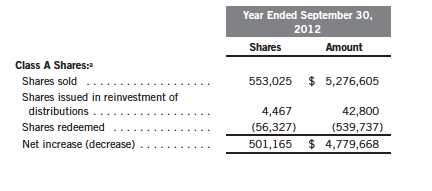
Annual Report | 33
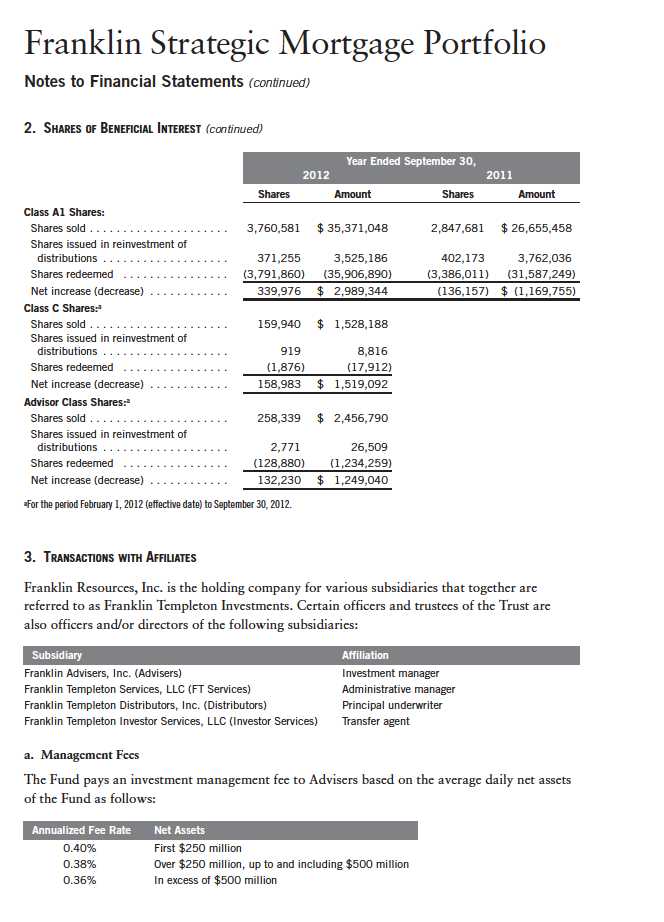
34 | Annual Report
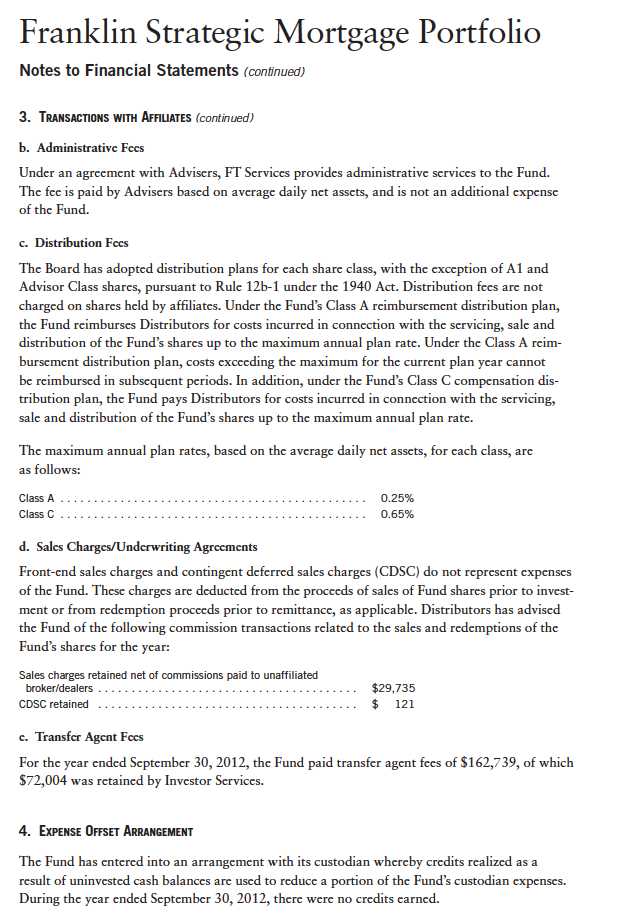
Annual Report | 35
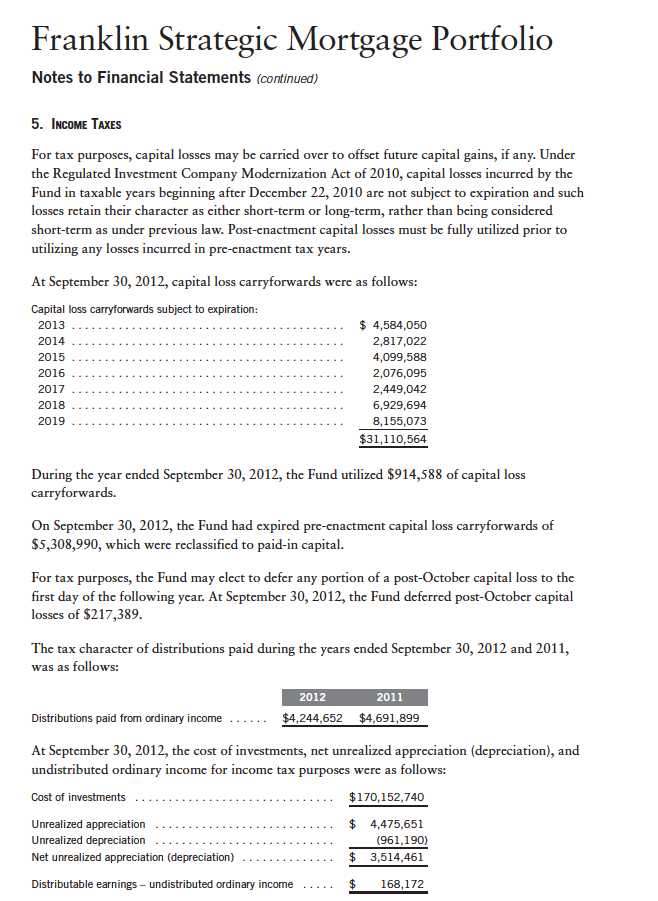
36 | Annual Report
Franklin Strategic Mortgage Portfolio
Notes to Financial Statements (continued)
5. INCOME TAXES (continued)
Differences between income and/or capital gains as determined on a book basis and a tax basis are primarily due to differing treatments of mortgage dollar rolls and paydown losses.
6. INVESTMENT TRANSACTIONS
Purchases and sales of investments (excluding short term securities) for the year ended September 30, 2012, aggregated $891,649,197 and $864,269,911, respectively.
7. INVESTMENTS IN INSTITUTIONAL FIDUCIARY TRUST MONEY MARKET PORTFOLIO
The Fund invests in the Institutional Fiduciary Trust Money Market Portfolio (Sweep Money Fund), an open-end investment company managed by Advisers. Management fees paid by the Fund are reduced on assets invested in the Sweep Money Fund, in an amount not to exceed the management and administrative fees paid by the Sweep Money Fund.
8. CONCENTRATION OF CREDIT RISK
The Fund has 18.9% of its portfolio invested in asset-backed and commercial mortgage-backed securities. Investments in these securities may subject the Fund to increased market volatility which may cause the Fund s net asset value per share to fluctuate. These investments may be less liquid than other investments held by the Fund.
9. OTHER DERIVATIVE INFORMATION
For the year ended September 30, 2012, the effect of derivative contracts on the Fund s Statement of Operations was as follows:
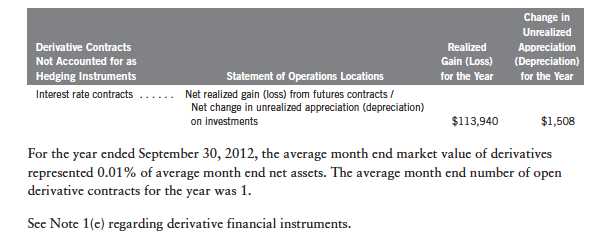
Annual Report | 37
Franklin Strategic Mortgage Portfolio
Notes to Financial Statements (continued)
10. CREDIT FACILITY
The Fund, together with other U.S. registered and foreign investment funds (collectively, Borrowers), managed by Franklin Templeton Investments, are borrowers in a joint syndicated senior unsecured credit facility totaling $1.5 billion (Global Credit Facility) which matures on January 18, 2013. This Global Credit Facility provides a source of funds to the Borrowers for temporary and emergency purposes, including the ability to meet future unanticipated or unusually large redemption requests.
Under the terms of the Global Credit Facility, the Fund shall, in addition to interest charged on any borrowings made by the Fund and other costs incurred by the Fund, pay its share of fees and expenses incurred in connection with the implementation and maintenance of the Global Credit Facility, based upon its relative share of the aggregate net assets of all of the Borrowers, including an annual commitment fee of 0.08% based upon the unused portion of the Global Credit Facility, which is reflected in other expenses on the Statement of Operations. During the year ended September 30, 2012, the Fund did not use the Global Credit Facility.
11. FAIR VALUE MEASUREMENTS
The Fund follows a fair value hierarchy that distinguishes between market data obtained from independent sources (observable inputs) and the Fund s own market assumptions (unobservable inputs). These inputs are used in determining the value of the Fund s financial instruments and are summarized in the following fair value hierarchy:
- Level 1 quoted prices in active markets for identical financial instruments
- Level 2 other significant observable inputs (including quoted prices for similar financial instruments, interest rates, prepayment speed, credit risk, etc.)
- Level 3 significant unobservable inputs (including the Fund s own assumptions in determining the fair value of financial instruments)
The inputs or methodology used for valuing financial instruments are not an indication of the risk associated with investing in those financial instruments.
For movements between the levels within the fair value hierarchy, the Fund has adopted a policy of recognizing the transfers as of the date of the underlying event which caused the movement.
38 | Annual Report
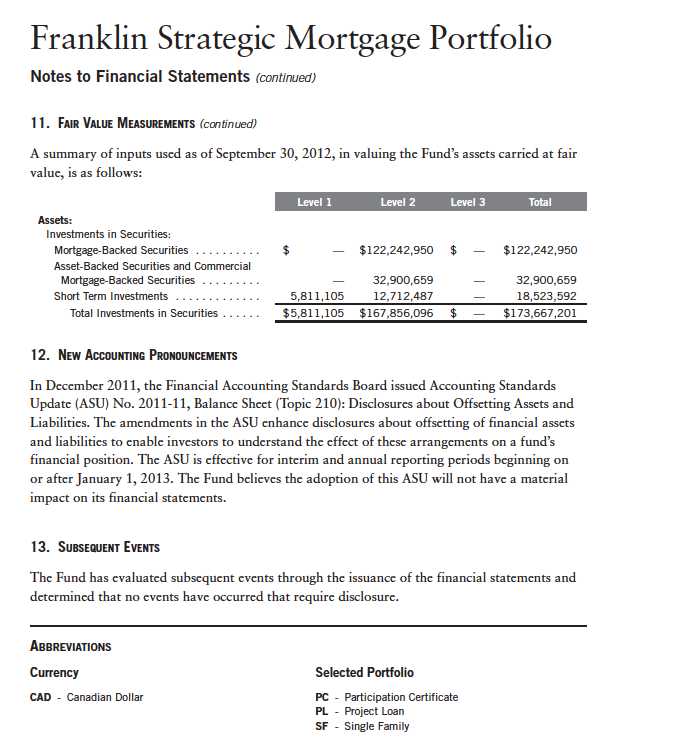
Annual Report | 39
Franklin Strategic Mortgage Portfolio
Report of Independent Registered Public Accounting Firm
To the Board of Trustees and Shareholders of Franklin Strategic Mortgage Portfolio
In our opinion, the accompanying statement of assets and liabilities, including the statement of investments, and the related statements of operations and of changes in net assets and the financial highlights present fairly, in all material respects, the financial position of Franklin Strategic Mortgage Portfolio (the Fund ) at September 30, 2012, the results of its operations for the year then ended, the changes in its net assets and the financial highlights for the periods presented, in conformity with accounting principles generally accepted in the United States of America. These financial statements and financial highlights (hereafter referred to as financial statements ) are the responsibility of the Fund s management. Our responsibility is to express an opinion on these financial statements based on our audits. We conducted our audits of these financial statements in accordance with the standards of the Public Company Accounting Oversight Board (United States). Those standards require that we plan and perform the audit to obtain reasonable assurance about whether the financial statements are free of material misstatement. An audit includes examining, on a test basis, evidence supporting the amounts and disclosures in the financial statements, assessing the accounting principles used and significant estimates made by management, and evaluating the overall financial statement presentation. We believe that our audits, which included confirmation of securities at September 30, 2012 by correspondence with the custodian and brokers, provide a reasonable basis for our opinion.
PricewaterhouseCoopers LLP
San Francisco, California
November 15, 2012
40 | Annual Report
Franklin Strategic Mortgage Portfolio
Tax Information (unaudited)
Under Section 871(k)(1)(C) of the Internal Revenue Code (Code), the Fund hereby reports the maximum amount allowable but no less than $3,401,935 as interest related dividends for purposes of the tax imposed under Section 871(a)(1)(A) of the Code for the fiscal year ended September 30, 2012.
Annual Report | 41
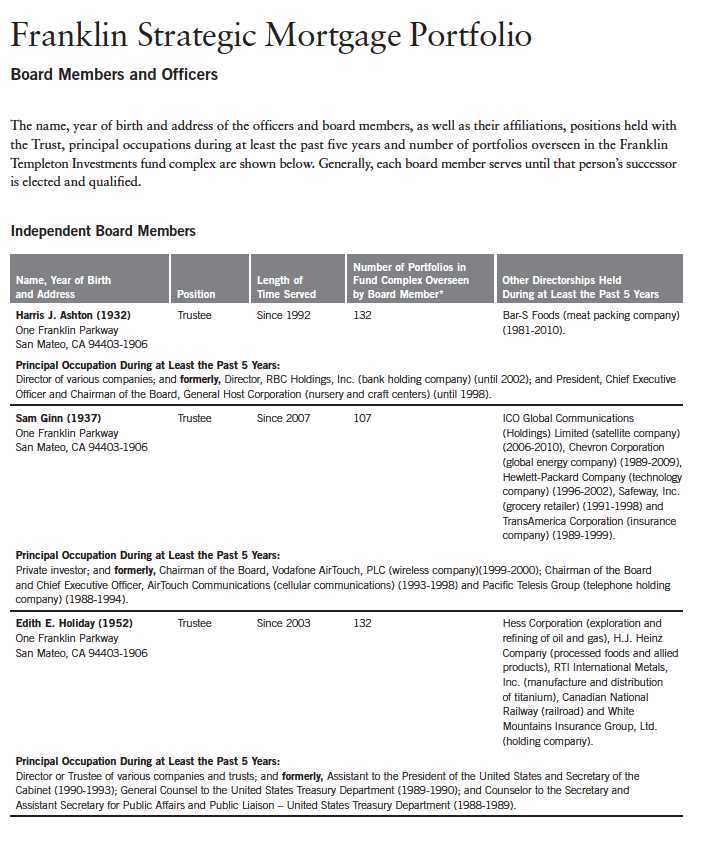
42 | Annual Report
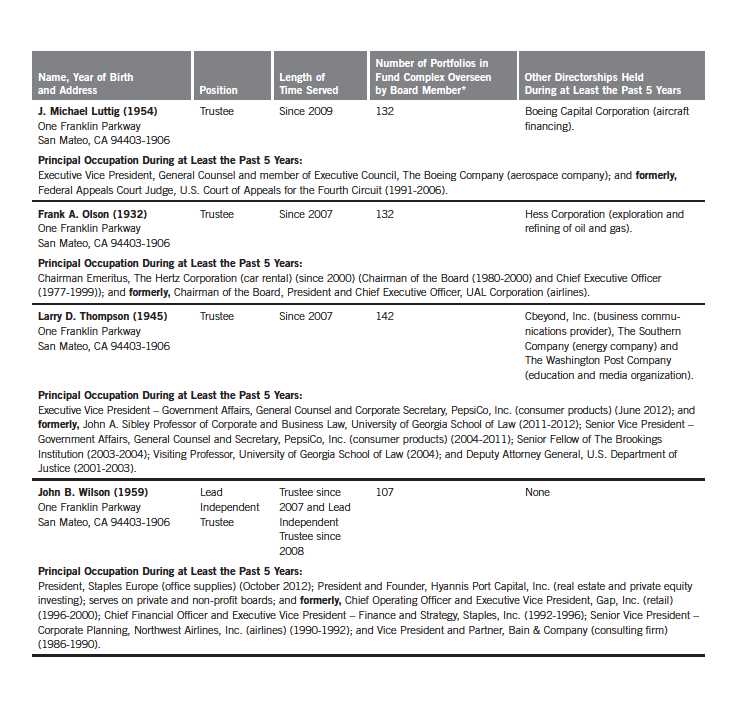
Annual Report | 43
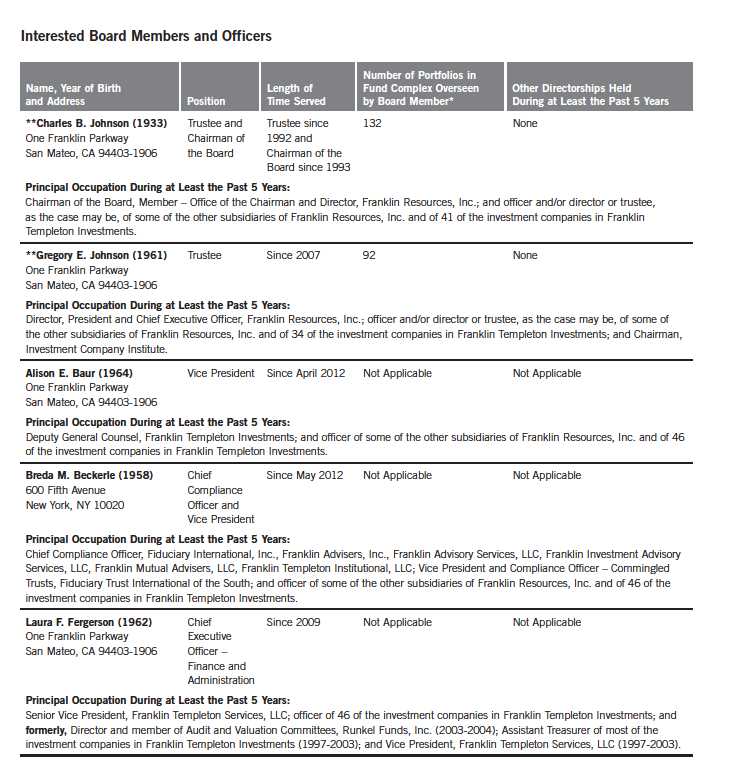
44 | Annual Report
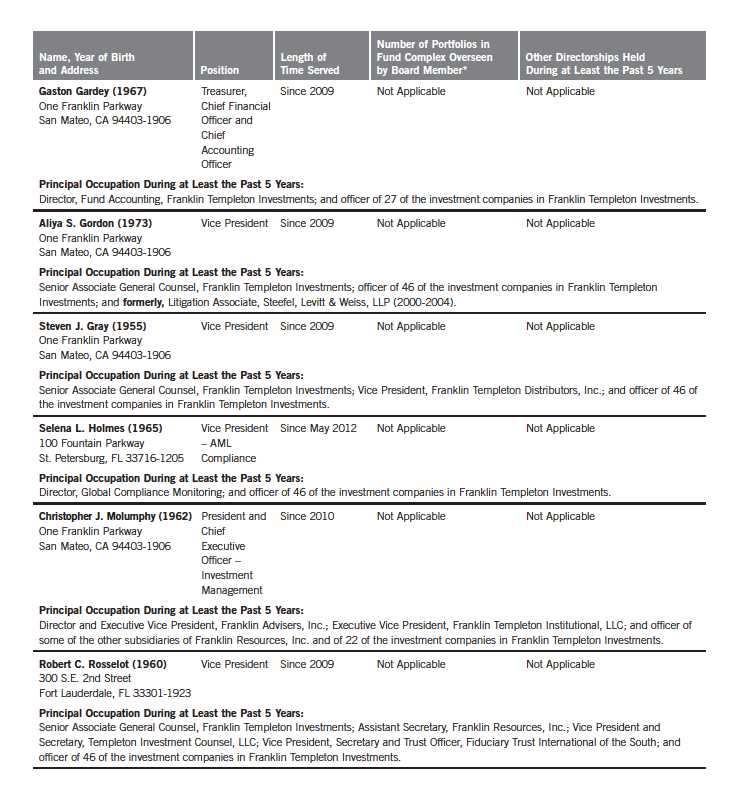
Annual Report | 45
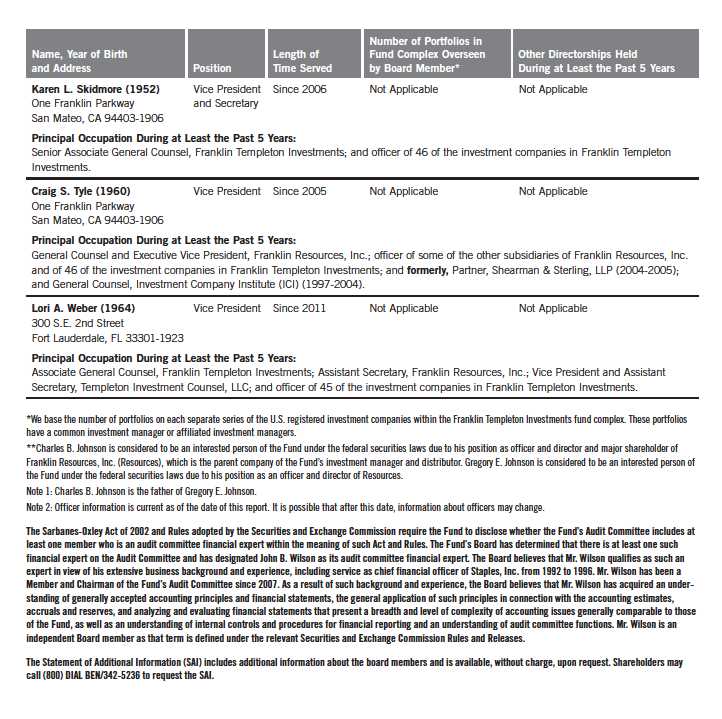
46 | Annual Report
Franklin Strategic Mortgage Portfolio
Shareholder Information
Proxy Voting Policies and Procedures
The Trust s investment manager has established Proxy Voting Policies and Procedures (Policies) that the Trust uses to determine how to vote proxies relating to portfolio securities. Shareholders may view the Trust s complete Policies online at franklintempleton.com. Alternatively, shareholders may request copies of the Policies free of charge by calling the Proxy Group collect at (954) 527-7678 or by sending a written request to: Franklin Templeton Companies, LLC, 300 S.E. 2nd Street, Fort Lauderdale, FL 33301, Attention: Proxy Group. Copies of the Trust s proxy voting records are also made available online at franklintempleton.com and posted on the U.S. Securities and Exchange Commission s website at sec.gov and reflect the most recent 12-month period ended June 30.
Quarterly Statement of Investments
The Trust files a complete statement of investments with the U.S. Securities and Exchange Commission for the first and third quarters for each fiscal year on Form N-Q. Shareholders may view the filed Form N-Q by visiting the Commission s website at sec.gov. The filed form may also be viewed and copied at the Commission s Public Reference Room in Washington, DC. Information regarding the operations of the Public Reference Room may be obtained by calling (800) SEC-0330.
Householding of Reports and Prospectuses
You will receive the Fund s financial reports every six months as well as an annual updated summary prospectus (prospectus available upon request). To reduce Fund expenses, we try to identify related shareholders in a household and send only one copy of the financial reports and summary prospectus. This process, called householding, will continue indefinitely unless you instruct us otherwise. If you prefer not to have these documents householded, please call us at (800) 632-2301. At any time you may view current prospectuses/summary prospectuses and financial reports on our website. If you choose, you may receive these documents through electronic delivery.
Annual Report | 47
This page intentionally left blank.
